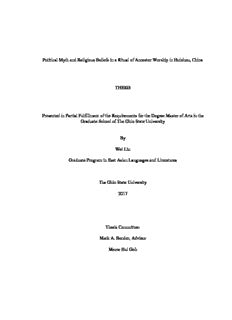
Political Myth and Religious Beliefs in a Ritual of Ancestor Worship in Huizhou, China THESIS ... PDF
Preview Political Myth and Religious Beliefs in a Ritual of Ancestor Worship in Huizhou, China THESIS ...
Political Myth and Religious Beliefs in a Ritual of Ancestor Worship in Huizhou, China THESIS Presented in Partial Fulfillment of the Requirements for the Degree Master of Arts in the Graduate School of The Ohio State University By Wei Liu Graduate Program in East Asian Languages and Literatures The Ohio State University 2017 Thesis Committee: Mark A. Bender, Advisor Meow Hui Goh Copyrighted by Wei Liu 2017 Abstract Ancestor worship is a common tradition in Anhui, China and its relevant ritual practices constitute an important part of local popular religion. It is now experiencing revival along with a flourishing of popular religion across mainland China in the wake of the reform era. Cultural and religious researchers have generated much interest in this widespread social phenomenon. They explain it as an attempt to fill a “spiritual vacuum” or simply as an effort to garner political and economic benefits. But I argue that we should avoid lumping a great variety of beliefs and practices together under the name of “popular religion,” trying to explain them as a whole. Instead, we must address the variety of form and theoretical significance of these practices. Examination of a particular form of local ritual can yield new and different insights into a set of cultural and social values behind it. This paper studies the symbolic meanings of the objects and behaviors in a style of ritual performance of ancestor worship in a small village of Huizhou area in eastern China. To analyze the symbolic meanings of this ritual and its social meanings, I use the performance approach and social analysis of ideological discourse to point out that there are religious and political realities intertwined and embodied in these performances. Therefore, the revival of ancestor worship is actually a move to reenact the ancient Confucian tradition of respecting ancestors and its myth of kingly governance and, thus, to cause common people to comply with the dominant political power in the ii modern context. My analysis facilitates the understanding of the vernacular aspect of Confucian ritual practices in terms of its role in carrying on the tradition, negotiating with the dominant official discourse and maintaining social cohesion. iii . Dedication For my mother, Mingxia明霞, who loves me unreservedly iv Acknowledgments There are many people to whom I would like to express my gratitude for their help during the process of writing this thesis. First and foremost, I would like to thank my advisor, Dr. Mark Bender, for his patient guidance, thought-provoking ideas, inspiring suggestions, and tireless efforts in revising the draft of my thesis. Not only has he imparted knowledge but he also has cared about my health, which moves me deeply. I also want to thank Dr. Meow Hui Goh, my committee member, for her helpful comments and criticisms, which have prodded me to think more deeply. Her literature class enabled me to experiment with various theoretical frameworks and analyze the Chinese literature that informs the practices I studied. I must also thank Dr. Amy Shuman, Dr. Kirk Denton, and Dr. Hugh Urban for their valuable advice and beneficial teaching methods. I am grateful to the teachers and scholars in the 227th Annual Meeting of American Oriental Society for their close attention to my project and advice for further research. I am indebted to all these enshi 恩師 great teachers who have shaped me. In addition, as the Chinese saying goes, “When you drink water, don’t forget those who dug the well” (heshui buwang dajingren 喝水不忘打井人). Most of all, I thank people in Qimen, Anhui. When I did my fieldwork there, they welcomed me v warmly and hosted me considerately. They were willing to provide any help I needed and all the information I asked for. They cherished the tradition, carried it on and wanted it to be known. My heart was constantly touched by their kindness and hospitality. At last, I am grateful to my mother who has supported me all through my life. . vi Vita Born February 20, 1990………………...…………………………………….Anhui, China 2008-2012…………………………………………………………..B.A. Anhui University 2013-2015………………………………………………………….M.A. Anhui University 2016-Present…………………………………………………………..Teaching Associate, Department of East Asian Languages and Literatures, The Ohio State University Fields of Study Major Field: East Asian Languages and Literatures Area of Interest: Chinese Literature, Oral Performance, Folklore, and Local Culture vii Table of Contents Abstract .......................................................................................................................... ii Dedication ..................................................................................................................... iv Acknowledgments ...........................................................................................................v Vita .............................................................................................................................. vii List of Figures .................................................................................................................x Chapter 1 Introduction .....................................................................................................1 Chapter 2 Literature Review .......................................................................................... 11 2.1 Performance Approach and Sociological Perspective ........................................... 11 2.2 Chinese Folk Beliefs and Practices ....................................................................... 15 2.2.1 Ancestor Worship in China ............................................................................ 15 2.2.2 Popular Religion in China .............................................................................. 21 2.2.3 Temple Worship in Huizhou .......................................................................... 27 Chapter 3 Contextualized Description of the Ritual Performance ................................... 34 3.1 Cultural Context of the Performance .................................................................... 35 3.2 Situational Context of the Performance ................................................................ 44 viii Chapter 4 Ritual Process in the Ancestral Hall ............................................................... 57 4.1 Setting of the Ritual.............................................................................................. 57 4.2 A Basic Understanding of Keys to Performance ................................................... 61 4.3 Transition in Liminality and Formation of a Communitas ..................................... 72 Chapter 5 Symbolic Social Constructs of Ritual Performance ........................................ 84 5.1 Sentiments of Affinity and Estrangement ............................................................. 85 5.2 Politics of Myth .................................................................................................... 89 5.3 Counter-myth in Social Reality ............................................................................ 93 Conclusion .................................................................................................................... 96 Bibliography ................................................................................................................ 101 ix
Description: